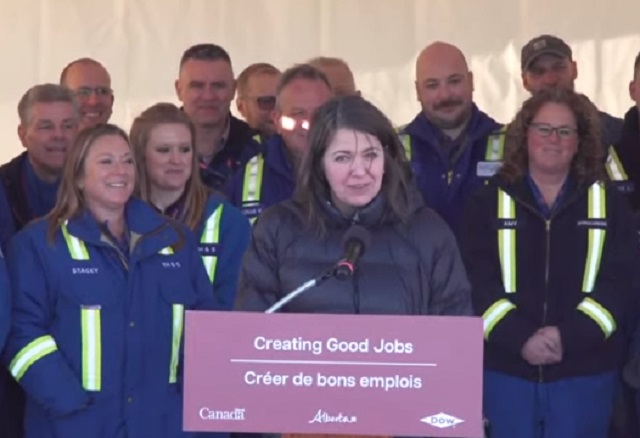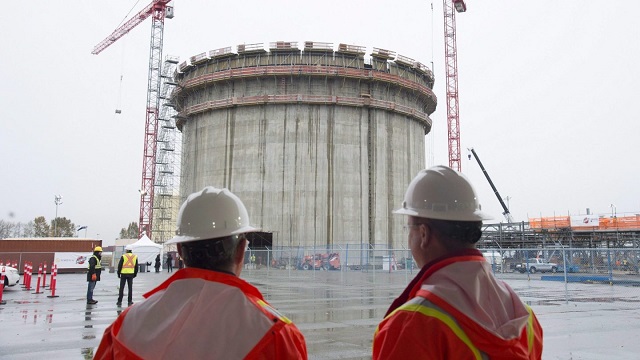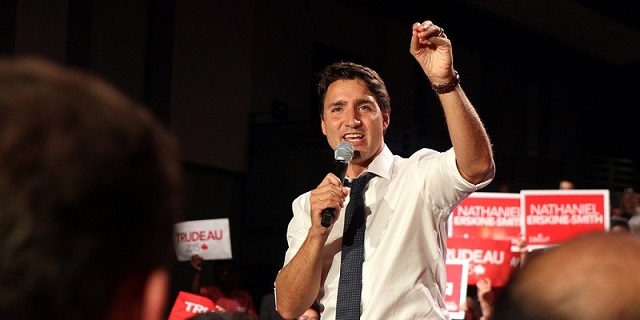Alberta
Multi-billion Dow Chemical investment pegs Alberta as a top spot for low carbon plastics production

The announcement Dow will construct the world’s first net-zero carbon emissions ethylene and derivatives complex, in Fort Saskatchewan, Wednesday November 29, 2023.
From the Canadian Energy Centre
By Will Gibson
Net zero petrochemical complex seen as a signpost for future investment in Alberta’s Industrial Heartland
Dow Chemical’s Nov. 28 announcement confirming it will invest $8.8 billion to build a net zero petrochemical complex near Edmonton was close to a decade in the making for Fort Saskatchewan Mayor Gale Katchur.
“Now that they’ve finally announced the project, I’m one of the happiest mayors around,” says Katchur, who was first elected in October 2010.
“What Dow is building will inspire other industries with innovation and technology like this. Dow has been a cornerstone for our community for the past 60 years. This investment ensures they are going to be around for a lot longer.”
The project, which has support from the municipal, provincial and federal governments, will increase Dow’s production of polyethylene, the most widely used plastic in the world.
Welcomed by the community
By capturing and storing carbon dioxide emissions and generating hydrogen on-site, the complex will be the world’s first ethylene cracker with net zero emissions from operations.
“I remember speaking to Dow executives during their regional visit some years back. They were curious about potential public concerns, given the visibility of their visit and the nature of their business,” Katchur says.
“My response was clear: the primary concern in our community is the pace of progress. People here recognize and appreciate the petrochemical industry. We understand the benefits that it brings.”
Competitive advantages
Katchur’s joy is shared by Mark Plamondon, executive director of Alberta’s Industrial Heartland Association, who sees the Michigan-based multinational’s decision as an endorsement of the region’s competitive advantages.
“Dow is a global company and could put their capital anywhere in the world,” says Plamondon, whose group attracts global investment in heavy industry to the 582-square-kilometre region northeast of Edmonton.
“What this demonstrates is Dow can meet both their economic and environmental goals by investing in this region. That sends a real message.”
Bob Masterson, CEO of the Chemistry Industry Association of Canada, sees Dow’s decision to build the facility as a signal of where the industry will make large investments in the future.
“In the short term, you are looking at the province’s largest construction project requiring more than 7,000 high-skill, high-paying jobs for the next seven to 10 years,” says Masterson, whose Ottawa-based group represents chemistry and plastics producers across Canada.
Alberta a top destination for low carbon chemical production
“What Dow’s decision really says is Alberta is a top destination for the chemistry industry to invest. One of the top chemical producers in the world is making this investment in Canada,” he says.
“When you look at the bigger picture, the only real rival for low-carbon investment of this kind is the U.S. Gulf Coast, where you have the same access to natural gas liquids as a feedstock and supportive public policy environment.”
The Industrial Heartland region is particularly attractive for companies looking to invest in low-carbon products, Masterson says.
“Alberta has an abundant low-carbon feedstock in natural gas liquids to produce hydrogen and the geological space to sequester carbon. These natural assets can encourage investment and support low-carbon chemistry industry,” he says.
“One of the largest petrochemical companies on the planet believes it can build a low-carbon chemistry plant based on these assets. Other companies will see they can generate and extract that value out of those resources in a very sustainable and responsible manner.”
Filling space on the Alberta Carbon Trunk Line
In addition to geological and natural resources, the region already possesses critical infrastructure to woo investment in low-carbon production, such as the Alberta Carbon Trunk Line (ACTL), the world’s largest CO2 pipeline.
Dow has signed an agreement with ACTL owner Wolf Midstream to utilize space on the system.
ACTL is the foundation of a hub that captures CO2 from an oil refinery and fertilizer plant and moves it for permanent storage in a nearby depleted oil field.
The pipeline currently transports 1.6 million tonnes of CO2 per year but is built to transport 14.6 million tonnes of CO2 per year.
“The infrastructure is in place already. The trunk line has plenty of surplus capacity to transport additional emissions,” Plamondon says.
“That just adds to the value proposition for potential facilities that are moving to low-carbon production.”
Alberta
Alberta government should eliminate corporate welfare to generate benefits for Albertans

From the Fraser Institute
By Spencer Gudewill and Tegan Hill
Last November, Premier Danielle Smith announced that her government will give up to $1.8 billion in subsidies to Dow Chemicals, which plans to expand a petrochemical project northeast of Edmonton. In other words, $1.8 billion in corporate welfare.
And this is just one example of corporate welfare paid for by Albertans.
According to a recent study published by the Fraser Institute, from 2007 to 2021, the latest year of available data, the Alberta government spent $31.0 billion (inflation-adjusted) on subsidies (a.k.a. corporate welfare) to select firms and businesses, purportedly to help Albertans. And this number excludes other forms of government handouts such as loan guarantees, direct investment and regulatory or tax privileges for particular firms and industries. So the total cost of corporate welfare in Alberta is likely much higher.
Why should Albertans care?
First off, there’s little evidence that corporate welfare generates widespread economic growth or jobs. In fact, evidence suggests the contrary—that subsidies result in a net loss to the economy by shifting resources to less productive sectors or locations (what economists call the “substitution effect”) and/or by keeping businesses alive that are otherwise economically unviable (i.e. “zombie companies”). This misallocation of resources leads to a less efficient, less productive and less prosperous Alberta.
And there are other costs to corporate welfare.
For example, between 2007 and 2019 (the latest year of pre-COVID data), every year on average the Alberta government spent 35 cents (out of every dollar of business income tax revenue it collected) on corporate welfare. Given that workers bear the burden of more than half of any business income tax indirectly through lower wages, if the government reduced business income taxes rather than spend money on corporate welfare, workers could benefit.
Moreover, Premier Smith failed in last month’s provincial budget to provide promised personal income tax relief and create a lower tax bracket for incomes below $60,000 to provide $760 in annual savings for Albertans (on average). But in 2019, after adjusting for inflation, the Alberta government spent $2.4 billion on corporate welfare—equivalent to $1,034 per tax filer. Clearly, instead of subsidizing select businesses, the Smith government could have kept its promise to lower personal income taxes.
Finally, there’s the Heritage Fund, which the Alberta government created almost 50 years ago to save a share of the province’s resource wealth for the future.
In her 2024 budget, Premier Smith earmarked $2.0 billion for the Heritage Fund this fiscal year—almost the exact amount spent on corporate welfare each year (on average) between 2007 and 2019. Put another way, the Alberta government could save twice as much in the Heritage Fund in 2024/25 if it ended corporate welfare, which would help Premier Smith keep her promise to build up the Heritage Fund to between $250 billion and $400 billion by 2050.
By eliminating corporate welfare, the Smith government can create fiscal room to reduce personal and business income taxes, or save more in the Heritage Fund. Any of these options will benefit Albertans far more than wasteful billion-dollar subsidies to favoured firms.
Authors:
Alberta
Official statement from Premier Danielle Smith and Energy Minister Brian Jean on the start-up of the Trans Mountain Pipeline

-

 Alberta1 day ago
Alberta1 day agoOfficial statement from Premier Danielle Smith and Energy Minister Brian Jean on the start-up of the Trans Mountain Pipeline
-

 Canadian Energy Centre2 days ago
Canadian Energy Centre2 days agoNorth America LNG project cost competitiveness
-

 Economy1 day ago
Economy1 day agoToday’s federal government—massive spending growth and epic betting
-

 Economy1 day ago
Economy1 day agoYoung Canadians are putting off having a family due to rising cost of living, survey finds
-

 COVID-191 day ago
COVID-191 day agoCanada’s COVID vaccine injury program has paid out just 6% of claims so far
-

 Environment24 hours ago
Environment24 hours agoClimate Alarmists Want To Fight The Sun. What Could Possibly Go Wrong?
-

 International2 days ago
International2 days agoNYPD storms protest-occupied Columbia building, several arrested
-

 International1 day ago
International1 day agoU.S. birth rate hit record low last year, signaling surge in childlessness









